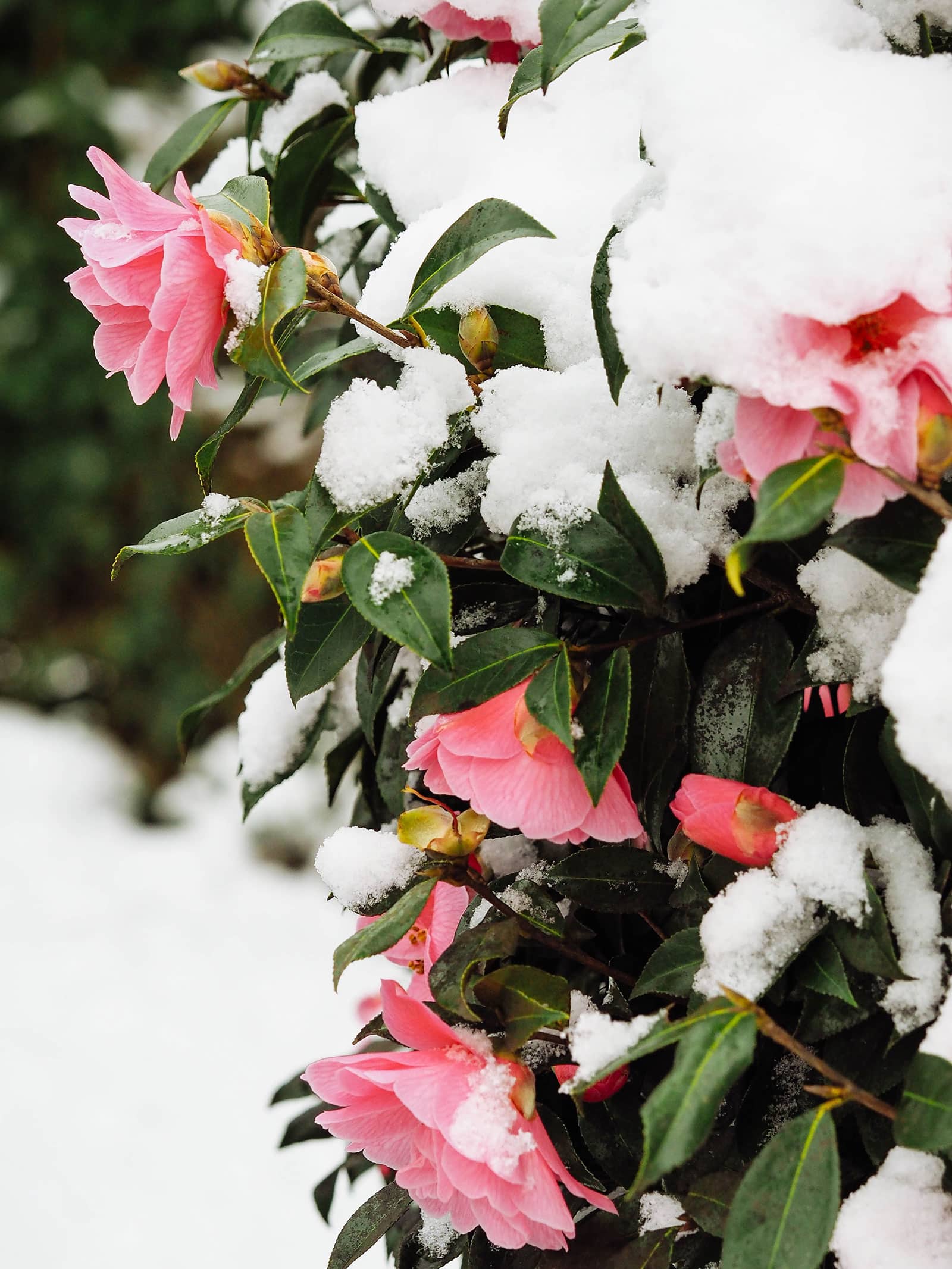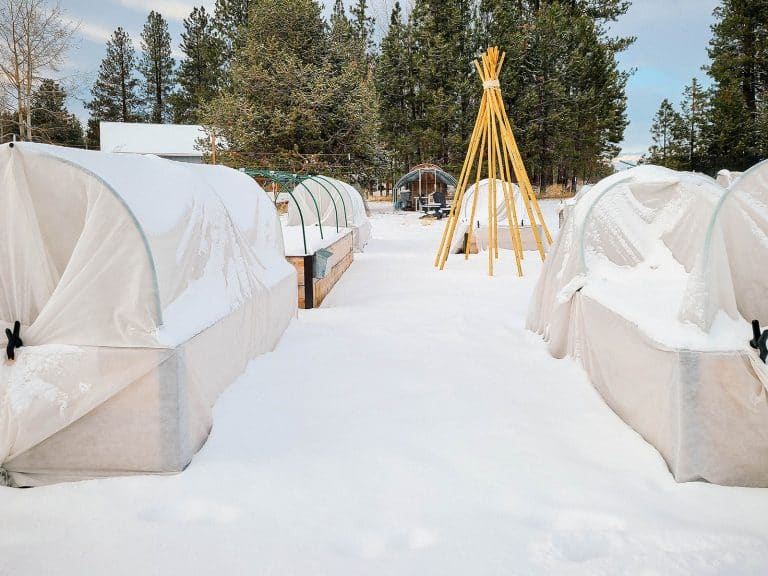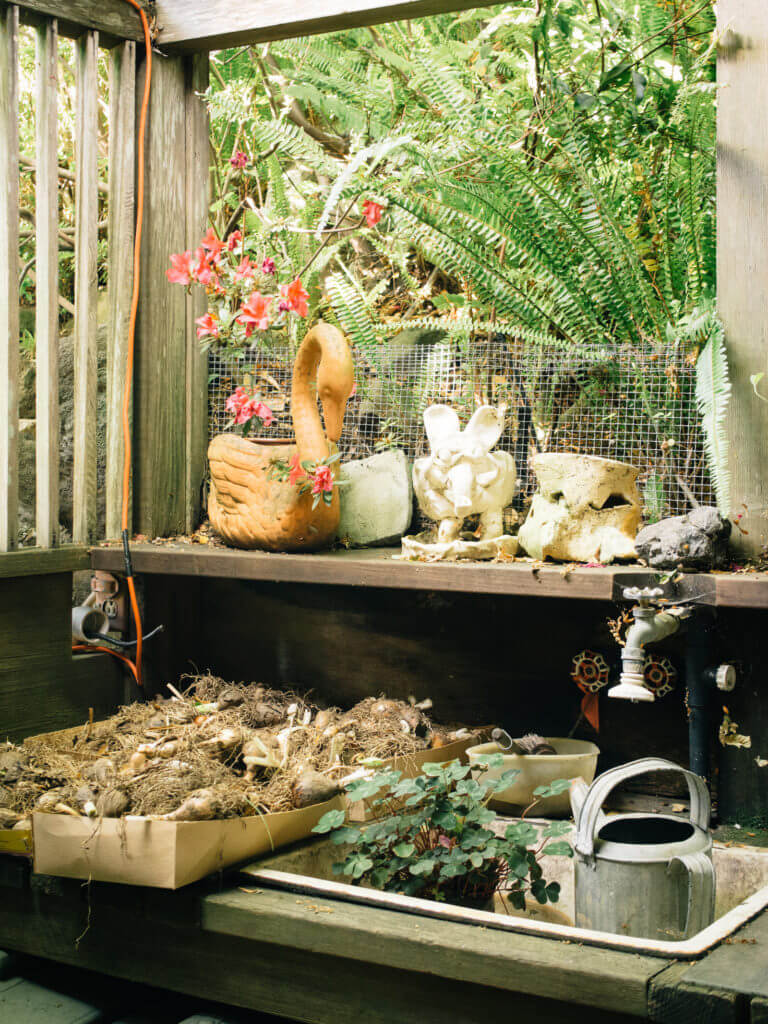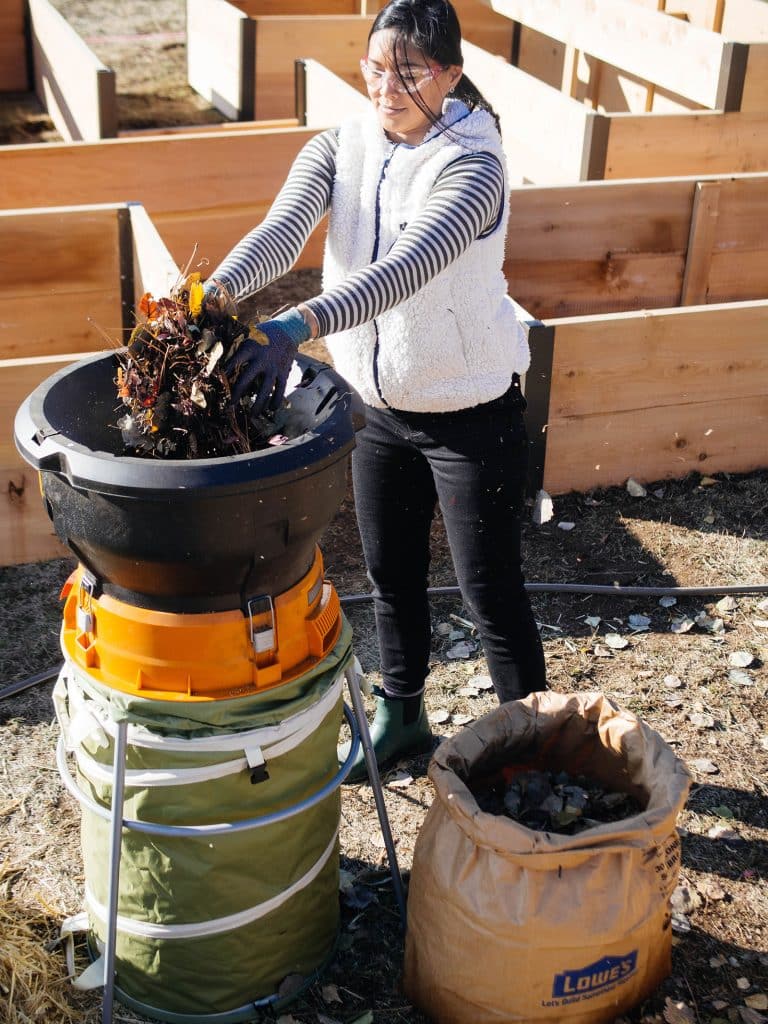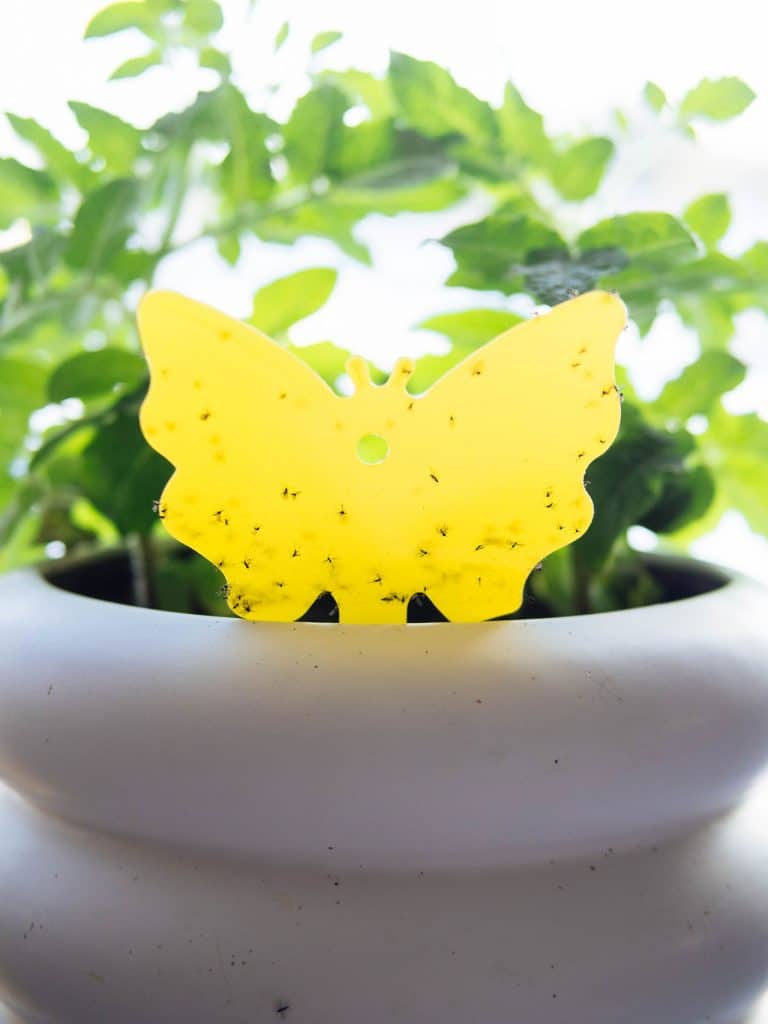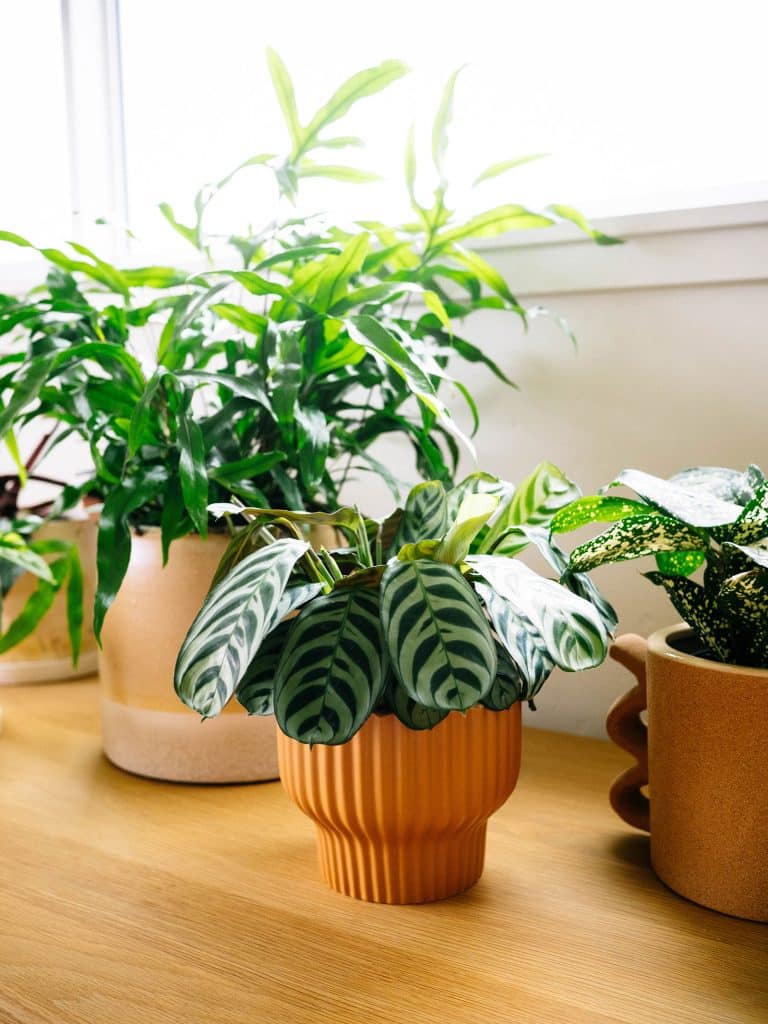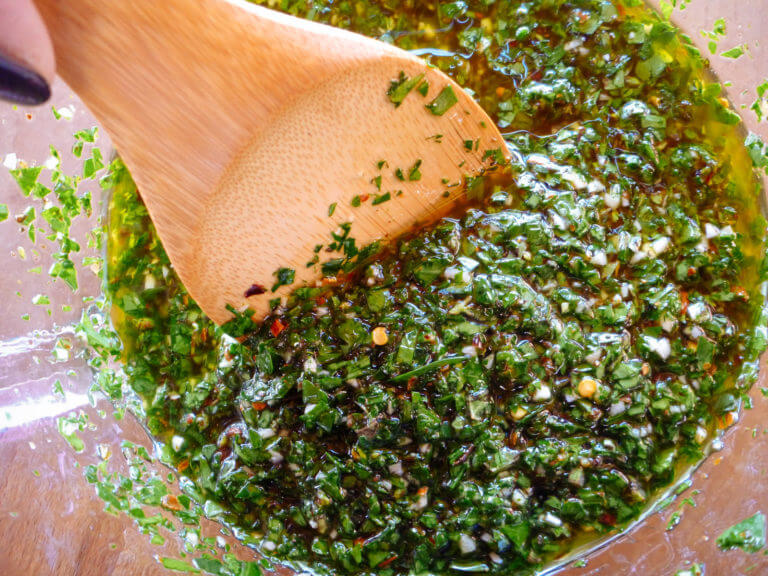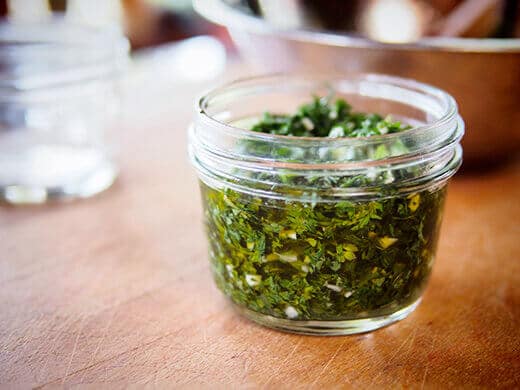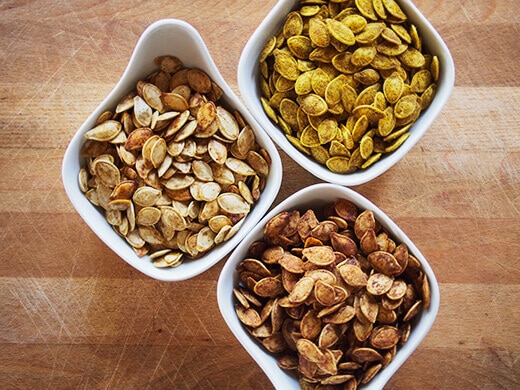For many climates, winter can be a pretty bleak period in the garden. After the beauty of your fall flowers fade, you’ve probably accepted that you have to wait until spring for the next round of color to appear. (And at one point, I did too.)
But here’s a secret: not every plant goes into hibernation once temperatures drop. Many annual and perennial flowers (and flowering shrubs) actually put on their best show in winter, blooming in a range of colors long before the ground has thawed and the snow has melted.
That means even those of us with frigid single-digit winters can enjoy a beautiful display when everything else in the garden is asleep! Some plants even bloom all winter long in mild climates, adding much-needed brightness to the season’s dark and dreary days.
If you want to spruce up your winter landscape, here are a few things to keep in mind:
- Many winter-flowering plants (including bulbs) need to go in the ground just as things start to cool down. Plant in fall (when the soil is still warm) so your plants have time to establish roots and build energy for a late winter bloom.
- Always check the USDA hardiness zone to make sure a plant is suitable for your climate. Some bulbs, for instance, won’t bloom in warmer regions since they need vernalization (a period of cold exposure) to trigger flower development.
- Actual bloom times will depend on the variety and your local microclimate. A plant may flower in December in milder areas, but colder regions may not see new growth until February. So, use the bloom times below as rough guidelines.
Disclosure: If you shop from my article or make a purchase through one of my links, I may receive commissions on some of the products I recommend.
Where to buy
Bulbs and live plants
December Bloomers
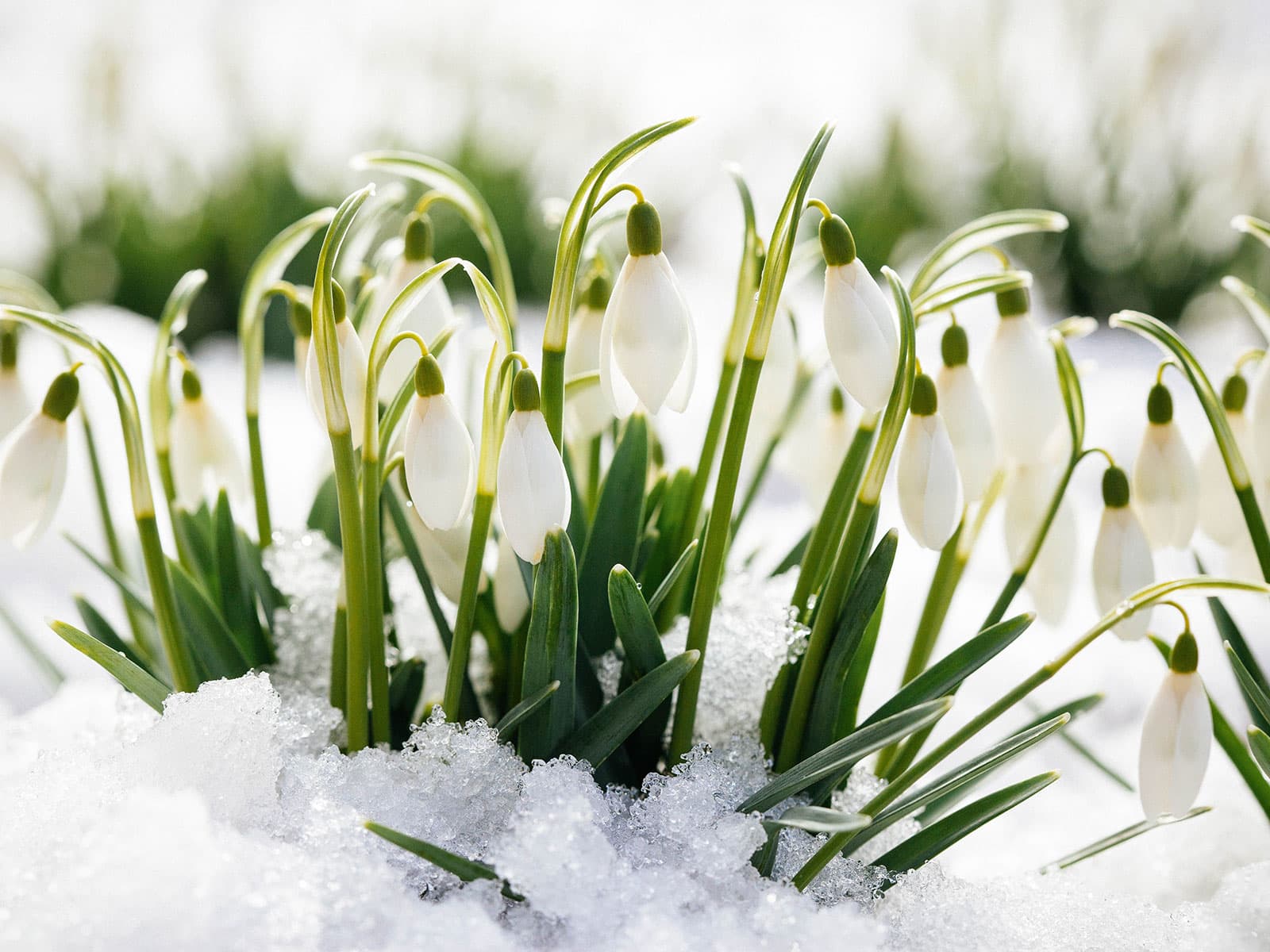
Snowdrop (Galanthus spp.)
- USDA Hardiness Zone: 3–7
- Sun Exposure: Full sun to partial shade
- Bloom Time: December to February
- Height/Spread: Up to 8 inches tall and 4 inches wide (will form larger clumps over time)
When the days are at their darkest, seeing the elegant little bell-shaped blooms of the ubiquitous snowdrop pop up is such a relief! One of the earliest bloomers around, they may produce flowers in December in mild regions, and even in places where it does get very cold, it’s not unusual to be able to enjoy them from January onward.
Snowdrops grow from diminutive bulbs (hence why they’re also called “minor bulbs”) and naturally spread over the years. They’re known for being super easy to maintain and resistant to critters; even beginning gardeners are unlikely to have trouble getting them to thrive.
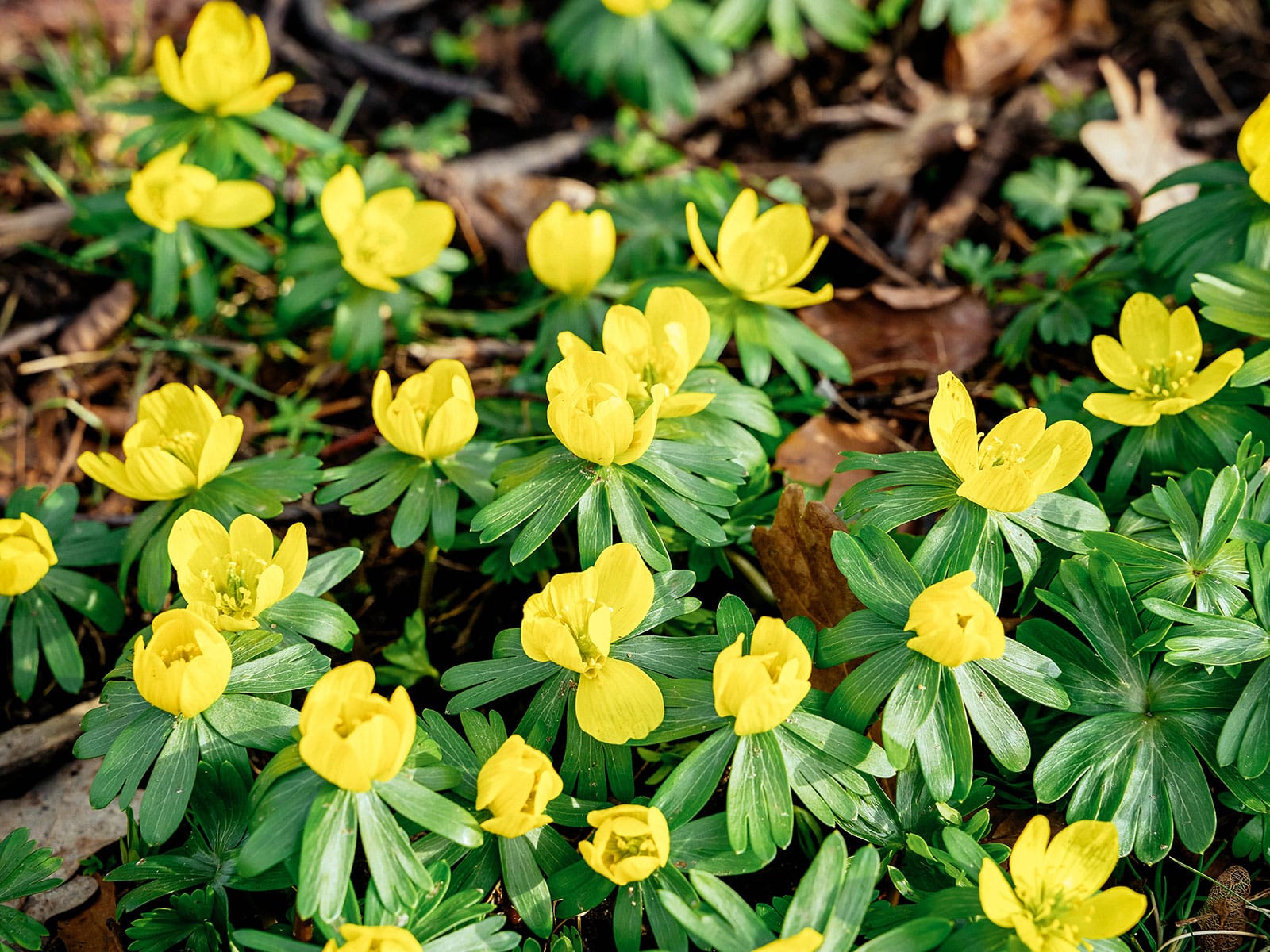
Winter aconite (Eranthis hyemalis)
- USDA Hardiness Zone: 4–8
- Sun Exposure: Full sun to light shade
- Bloom Time: December to February
- Height/Spread: Up to 6 inches tall and 6 inches wide (will form larger clumps over time)
Is that buttercup? Nope, just winter aconite, another very early bloomer whose dainty golden flowers tend to pop up right alongside your snowdrops. This tuberous perennial can form large clumps over the years, brightening your winter garden with big patches of cheerful color.
Winter aconite is deer-resistant and not fussy. It looks great pretty much anywhere, but especially around trees and shrubs or along a walkway.
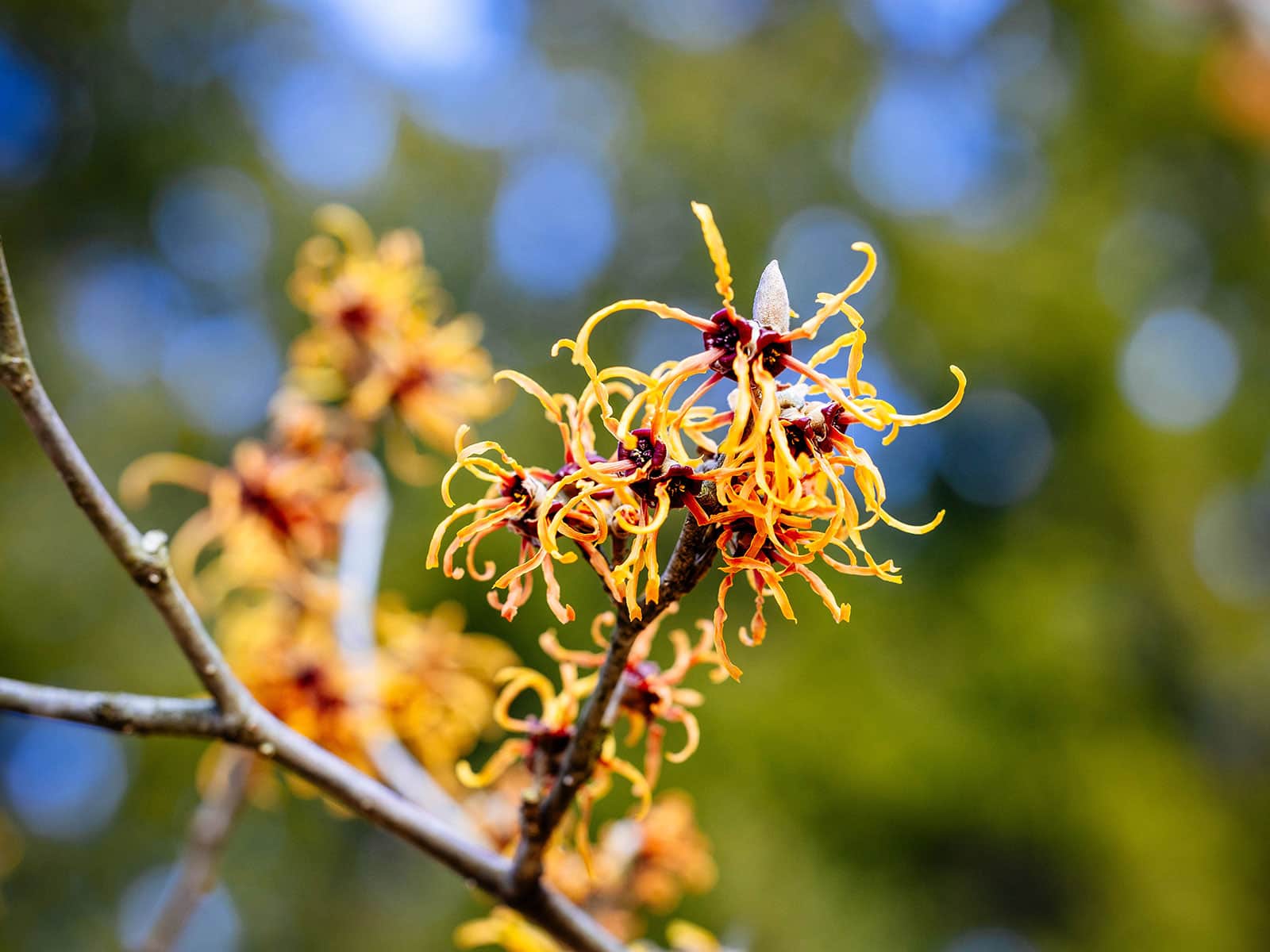
Witch hazel (Hamamelis spp.)
- USDA Hardiness Zone: 3–8
- Sun Exposure: Full sun to partial shade
- Bloom Time: December to February
- Height/Spread: Up to 20 feet tall and 15–20 feet wide
There are many different species of witch hazel and even more man-made cultivars, but what all these tall deciduous shrubs have in common is that their unusual, spider-like flowers appear in the dead of winter. December is not an unusual blooming time at all, and you can enjoy the yellow, red, or orange blooms throughout the cold season.
Did you know?
Witch hazel extract, which you can make yourself from the plant’s bark, is an astringent commonly used in skincare formulations like aftershaves.
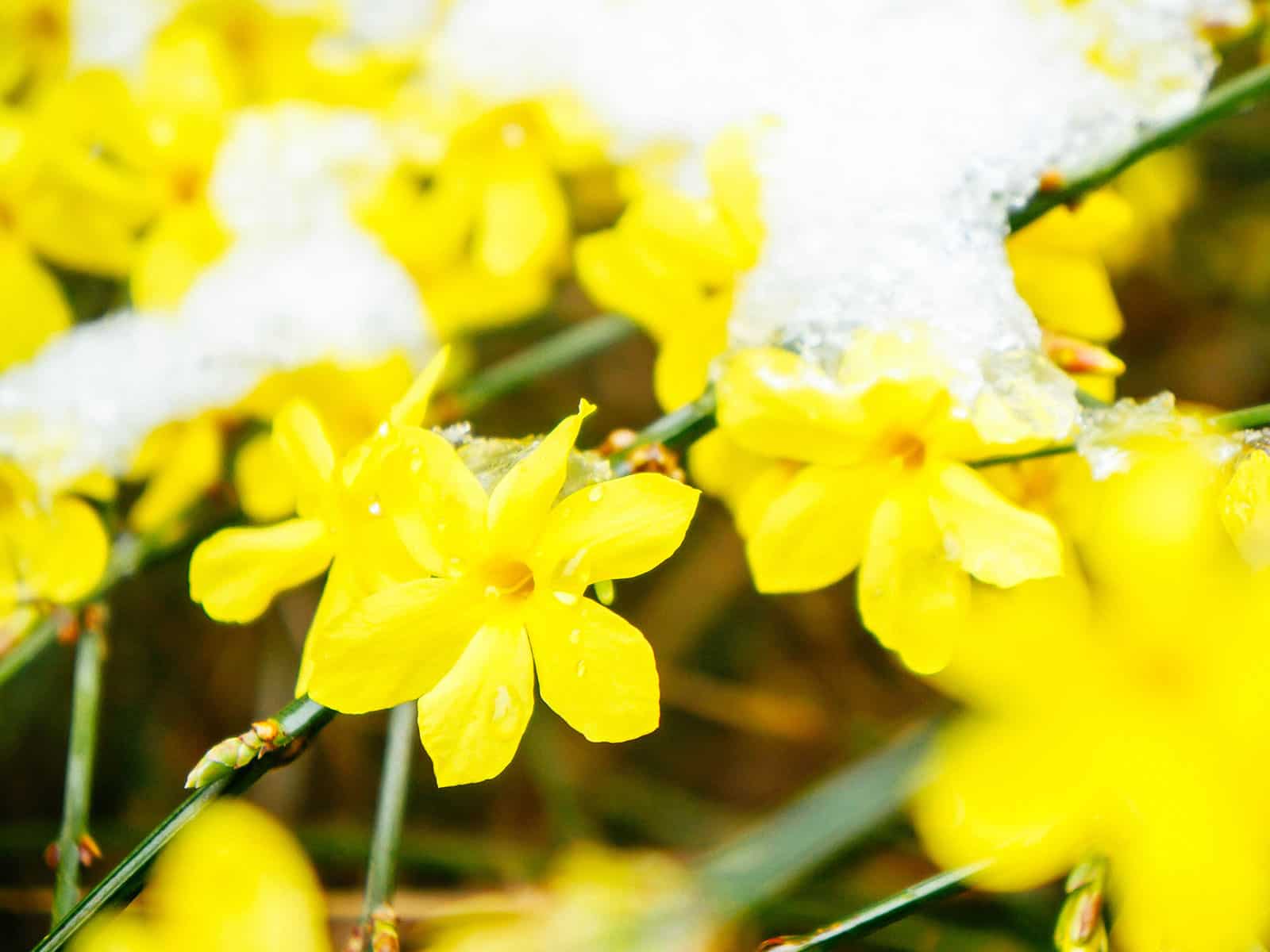
Winter jasmine (Jasminum nudiflorum)
- USDA Hardiness Zone: 6–10
- Sun Exposure: Full sun to partial shade
- Bloom Time: December to March
- Height/Spread: Up to 4 feet (as a shrub) or 15 feet (as a vine) tall and 6 feet wide
One of the plants I enjoy most during the darkest winter months is winter jasmine, a deciduous shrub with elegant, cascading branches. This species can bloom as early as December, becoming totally covered in a blanket of little yellow blossoms that look quite similar to Forsythia (which belongs to the same family).
Winter jasmine looks great draped over walls or on a trellis. It’s low-maintenance and should be easy to grow even for beginning gardeners.
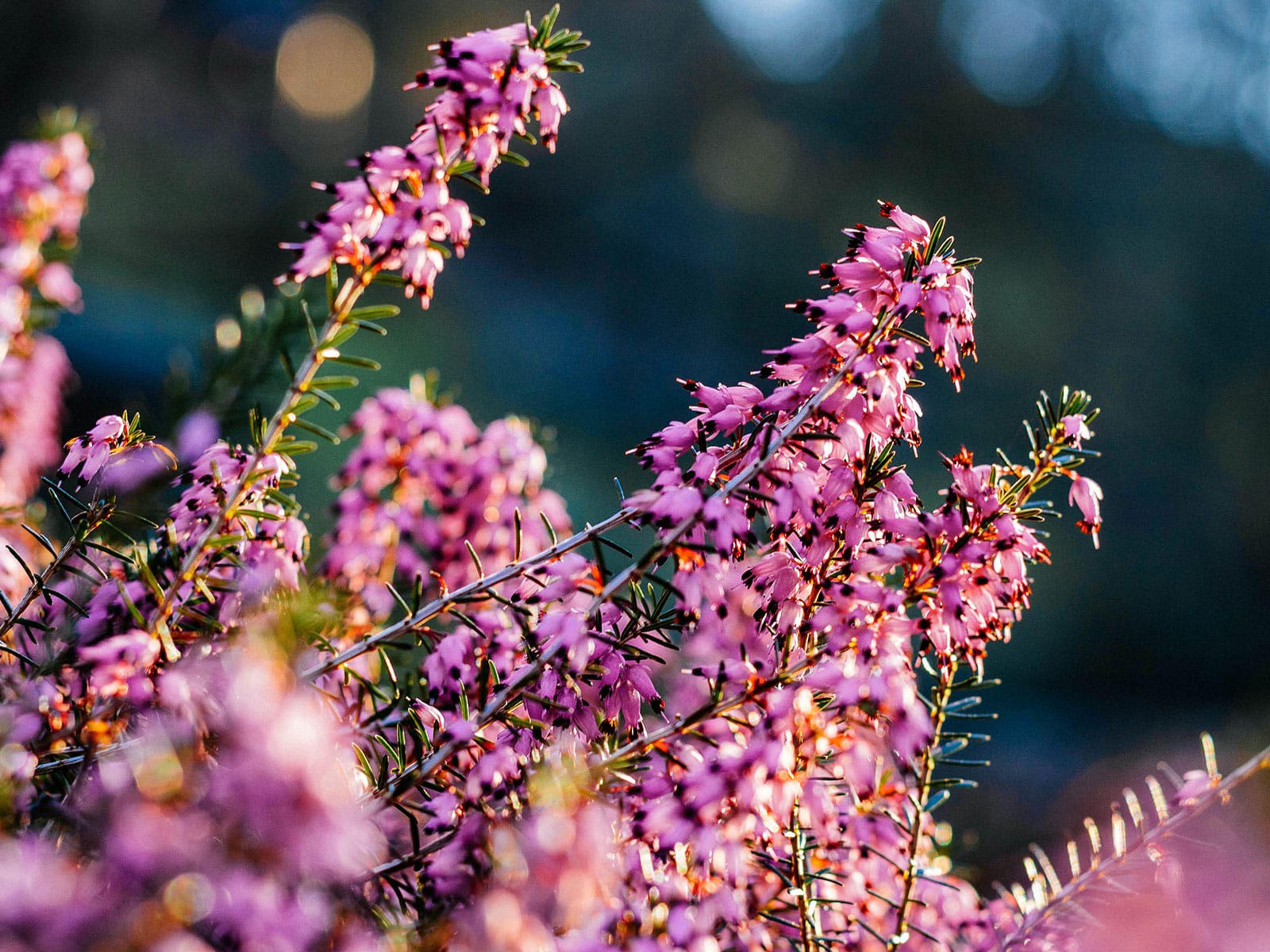
Winter heath (Erica carnea)
- USDA Hardiness Zone: 5–8
- Sun Exposure: Full sun
- Bloom Time: December to May
- Height/Spread: Up to 10 inches tall and 2 feet wide
Need some serious color to cheer you up during the cold winter months? You got it! Winter heath is available in a range of flower shades, including white, pale pink to fuchsia, and bright purple. The tiny bell-shaped blooms hang in great quantities from the shrubby branches, even when there’s still snow on the ground.
Another easy plant to grow, this one’s unattractive to deer and not prone to disease or pests. It likes a sandy, acidic soil with good drainage.
January Bloomers
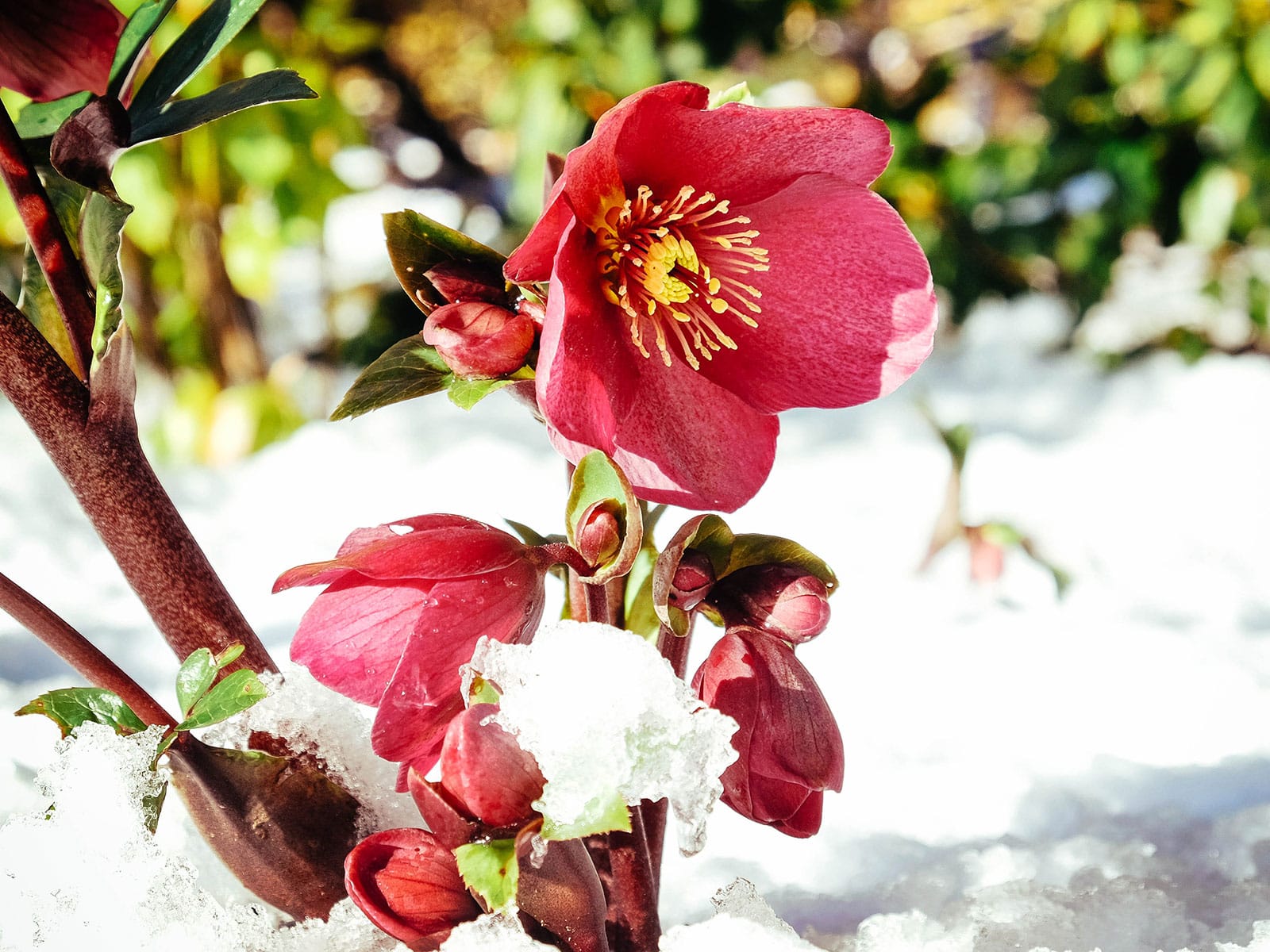
Hellebore (Helleborus spp.)
- USDA Hardiness Zone: 4–9
- Sun Exposure: Partial shade (more sun is okay in winter)
- Bloom Time: January to April
- Height/Spread: Generally up to 15 inches tall and 2 1/2 feet wide
There are more hellebore species and cultivars than I can begin to describe here, with a dazzling array of different flower colors and shapes. Also known as lenten roses, hellebores can bloom very early depending on the species—and the nodding, cup-shaped flowers can last for several weeks.
Give your hellebores a nice and shaded spot where they’re protected from the harsher summer sun, preferably in fertile and somewhat moist soil, such as below a tree or shrub. These plants are easy to grow, though keep in mind that they’re toxic to humans and animals.
February Bloomers
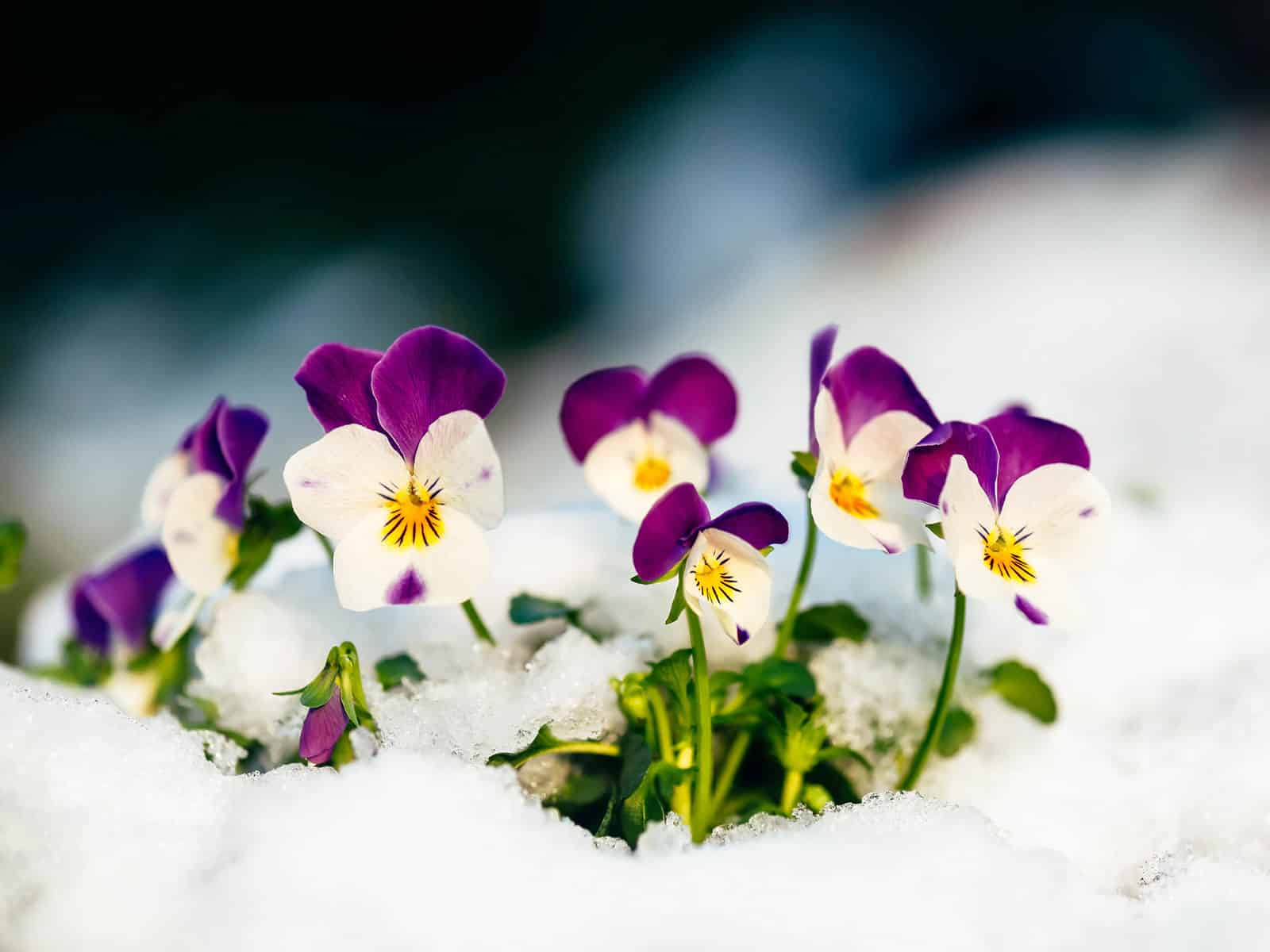
Violet (Viola spp.)
- USDA Hardiness Zone: 3–8
- Sun Exposure: Full sun, but partial shade in summer
- Bloom Time: February to June
- Height/Spread: Up to 8 inches tall and 10 inches wide
The genus Viola, the violets, contains over 600 species, not to mention the hundreds of selectively cultivated varieties to be found for sale. That means plenty to choose from, and as a bonus, you can enjoy their lovely blooms as early as January (though usually February). In mild climates, they may even start producing flowers in fall and not stop until early summer!
I especially love violets for another (less conventional) reason: they’re one of the best-tasting edible flowers, with the whole plant (flower petals and leaves) being safe to consume. Try them in a salad!
Violets like sun but don’t respond well to heat. Although they’re somewhat sensitive to pests and predation, they’re easy to grow, and individual plants can live for up to three years.
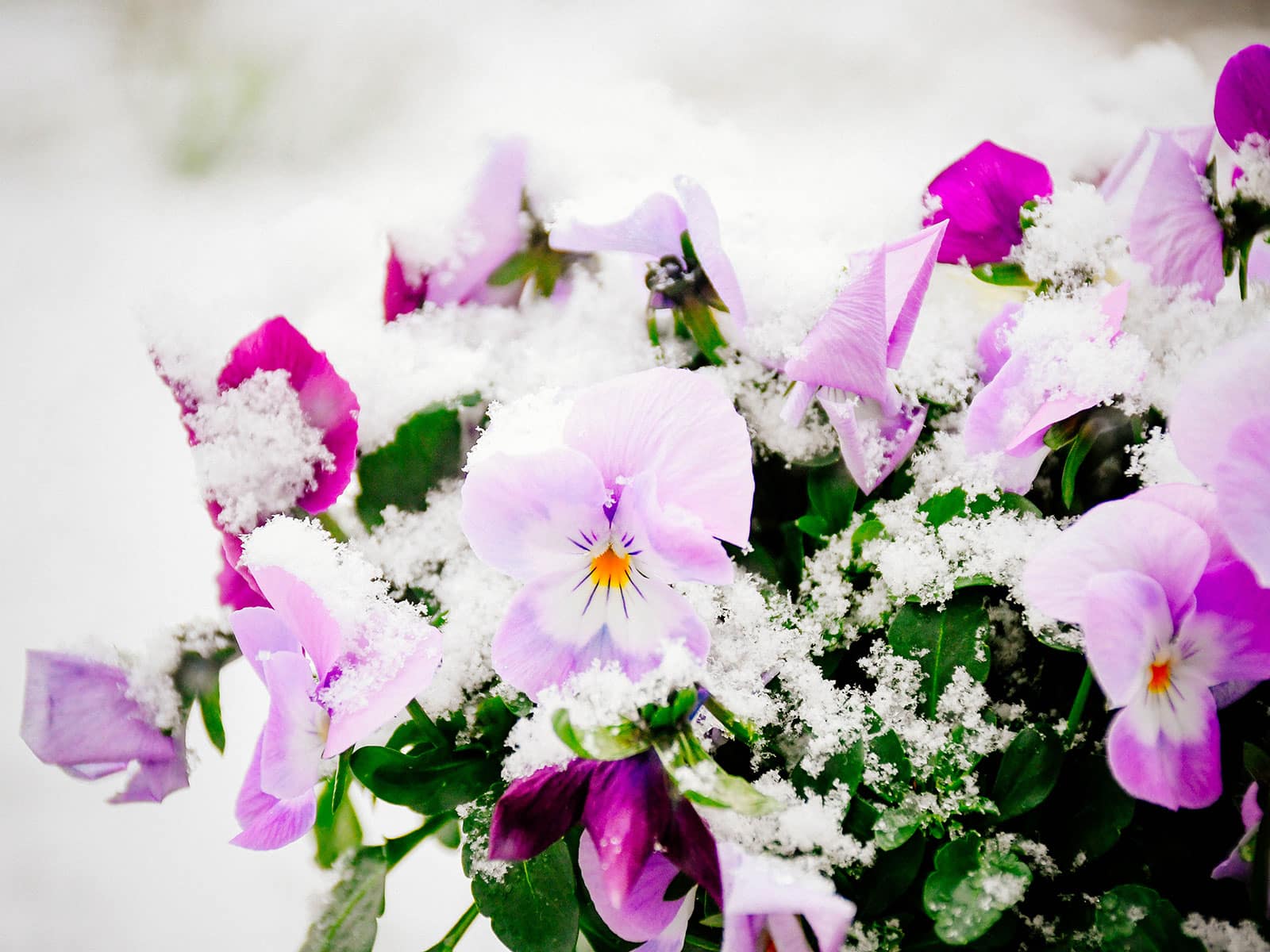
Pansy (Viola x wittrockiana)
- USDA Hardiness Zone: 6–10 (might not survive hot summers)
- Sun Exposure: Full sun, but partial shade in summer
- Bloom Time: February to June
- Height/Spread: Up to 10 inches tall and 12 inches wide
One type of Viola I want to put in the spotlight is the ubiquitous pansy, a hybrid between Viola tricolor (Johnny-jump-up) and other species in the genus. What’s unique about these beautiful bloomers is that they usually have two flowering periods: fall through early winter (followed by a dormancy) and then again from early spring to early summer.
I’ve listed pansies as starting in February here, but during mild winters, you may see their multicolored blooms appearing as early as January!
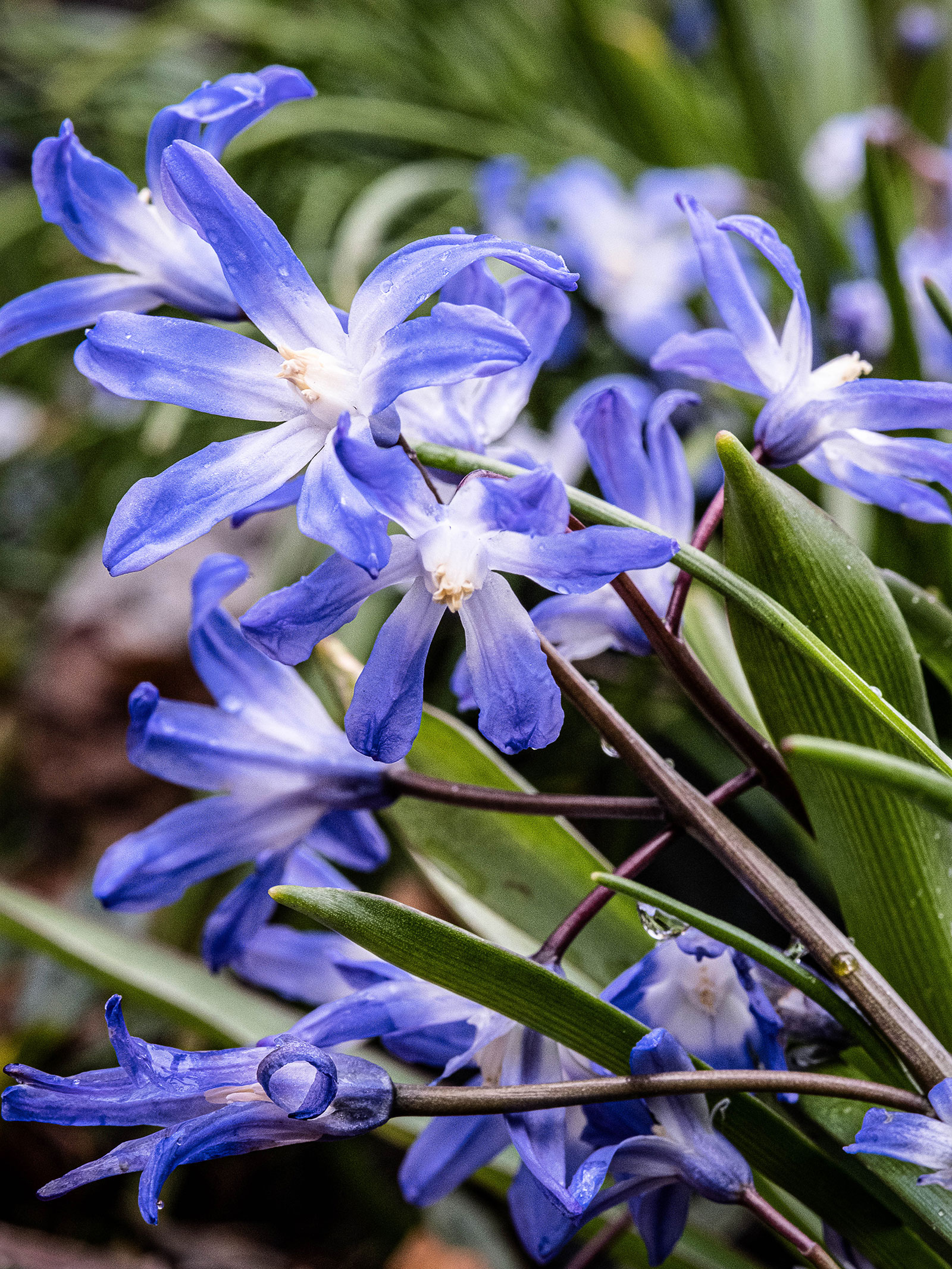
Glory-of-the-snow (Scilla luciliae)
- USDA Hardiness Zone: 3–8
- Sun Exposure: Full sun to light shade
- Bloom Time: February to March
- Height/Spread: Up to 6 inches tall and wide (will form larger clumps over time)
I’ve planted my garden with a bunch of different bulbs that all begin to bloom at slightly different times. The first are snowdrops (discussed at the top of this list), followed a few weeks later by this beautiful little number: glory-of-the-snow, which can form dense mats of low, star-shaped, blue-ish purple blooms.
You can plant clusters of glory-of-the-snow bulbs in fall to enjoy them as early as February. They look great in lawns, under trees, and in rock gardens, and are resistant to critters and deer.
Quick tip
I also love the closely related Scilla siberica, which blooms slightly later but makes up for its tardiness with lovely, bluebell-like flowers.
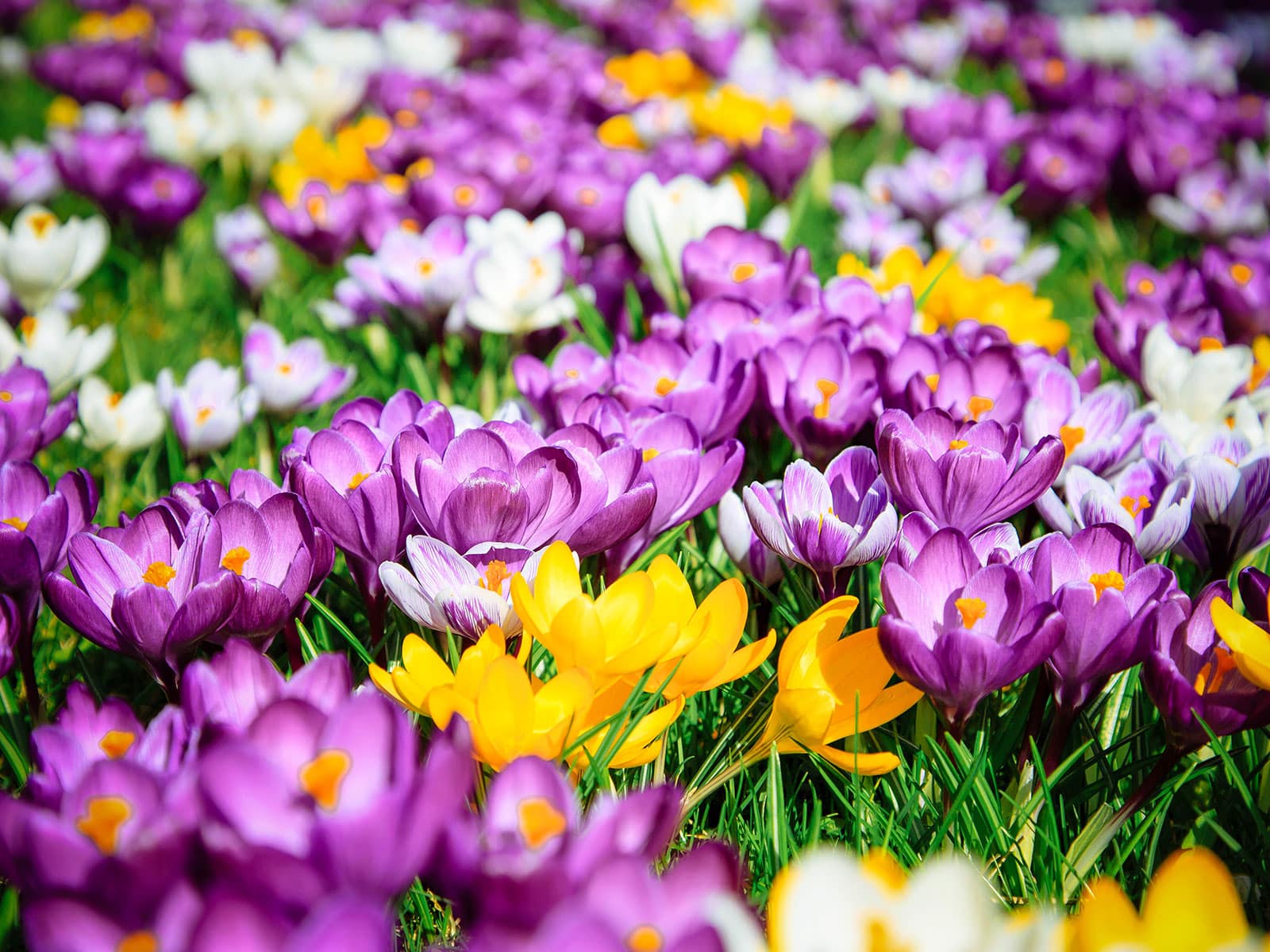
Crocus (Crocus spp.)
- USDA Hardiness Zone: 3–8
- Sun Exposure: Full sun to partial shade
- Bloom Time: February to April
- Height/Spread: Up to 5 inches tall and wide (will form larger clumps over time)
Say hello to my favorite on the list! Seeing differently colored crocuses peep out of my lawn, which happens just after the appearance of the aforementioned glory-of-the-snow is always a sure sign to me that the worst of winter is over.
Their shades of white, purple, and yellow, surrounded by grassy foliage, appear slightly after the aforementioned glory-of-the-snow and are enough to cheer anyone up on a bright morning.
Crocuses can be planted in fall in sunny to half-shaded spots like lawns or under trees. The bulbs, which are very easy to grow, will divide themselves to form larger mats of flowers over the years.
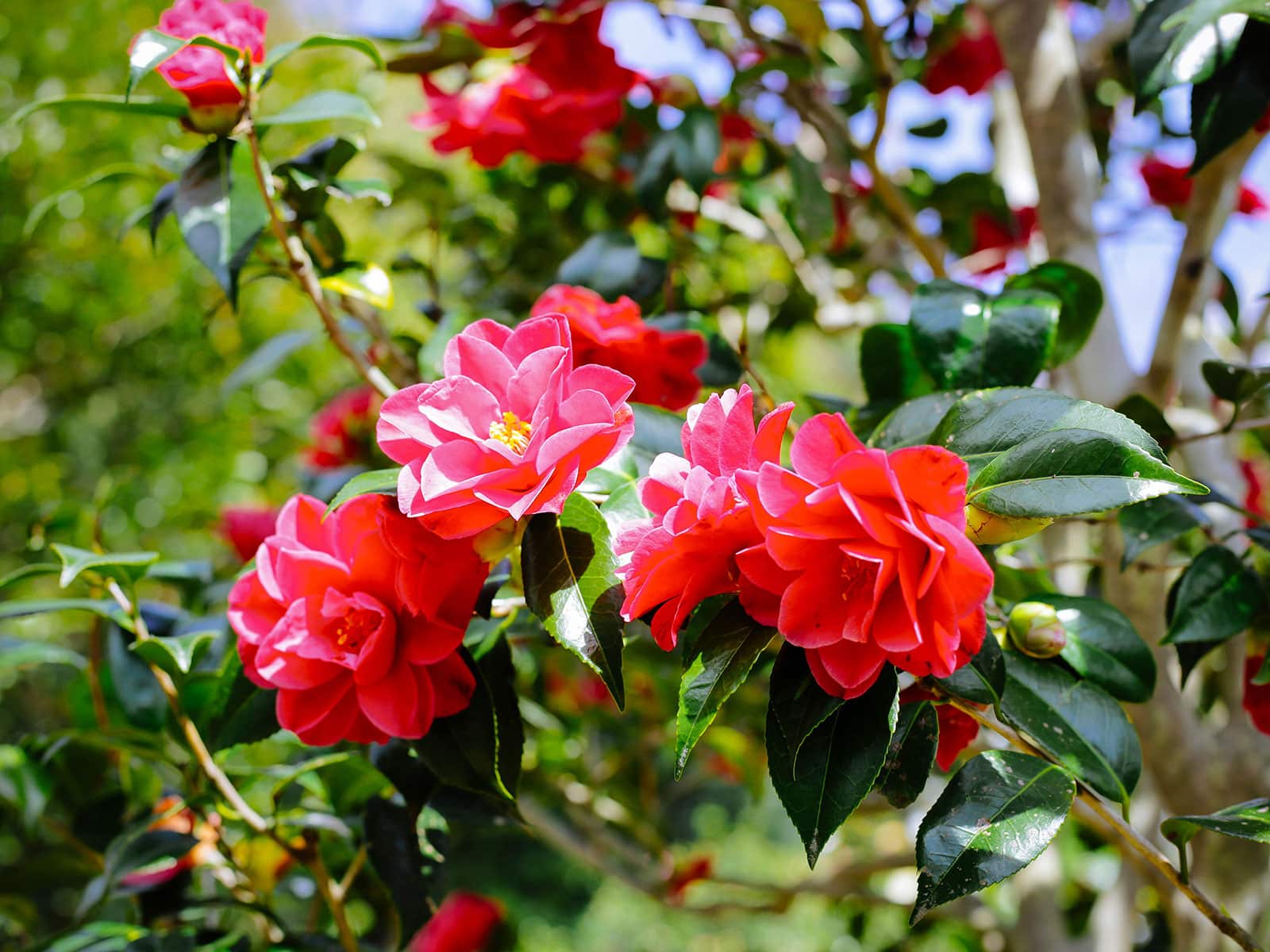
Camellia (Camellia spp.)
- USDA Hardiness Zone: 7–10
- Sun Exposure: Partial shade
- Bloom Time: February to March
- Height/Spread: Up to 15 feet tall and 10 feet wide
What if you could have roses, but in February? Okay, sure, Camellias are not exactly the same thing, but they sure look similar enough! Many of the species commonly grown in gardens are naturally found in parts of East Asia that can get rather chilly, so they’re not afraid of a little cold.
Camellia flowers can be single-layered, but the majority of cultivars features lush, ruffled flowers with abundant petals in beautiful shades of pink. These large shrubs work in hedges or as a potted centerpiece, and most gardeners find them easy to grow.
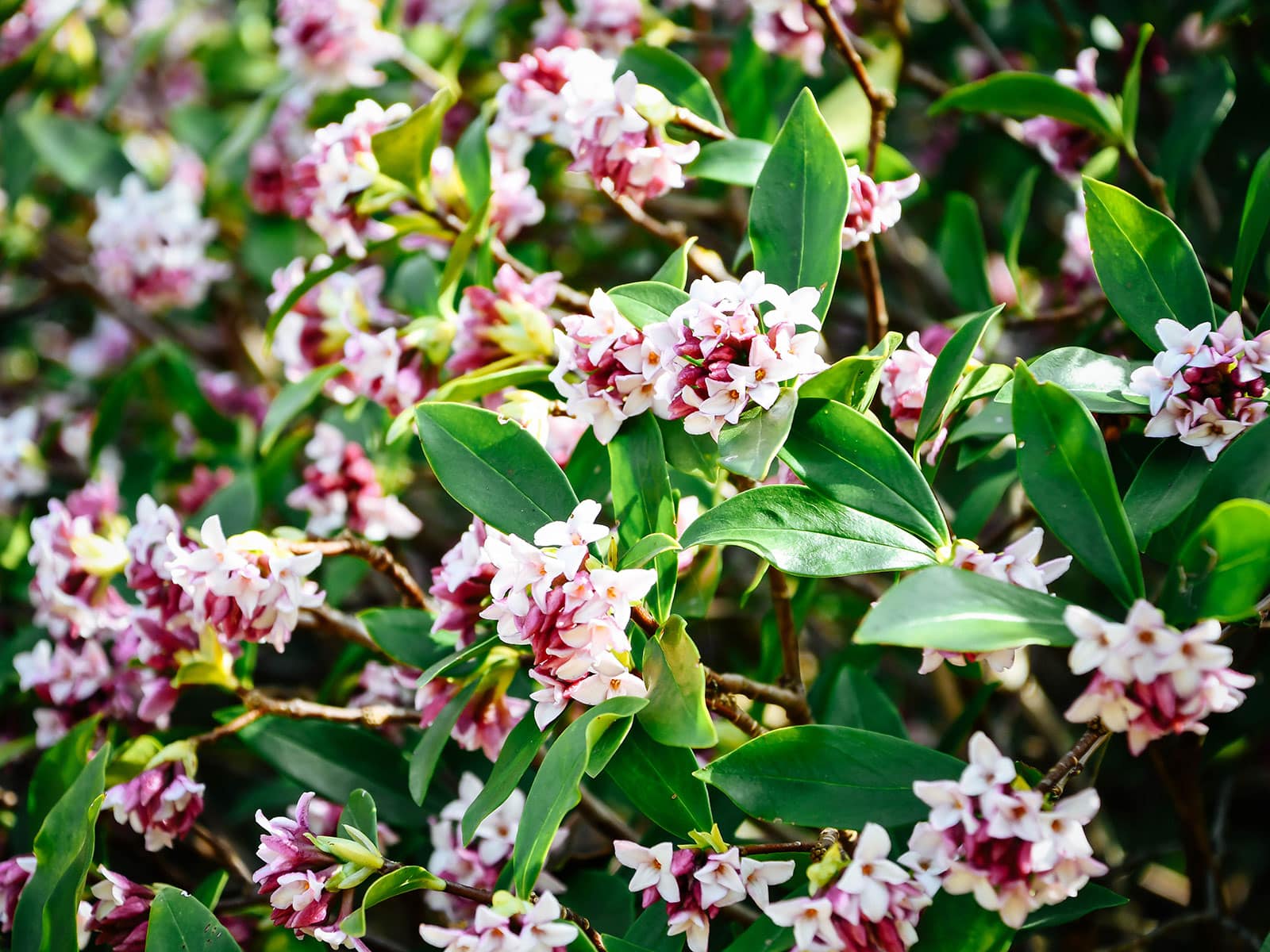
Winter daphne (Daphne odora)
- USDA Hardiness Zone: 7–10
- Sun Exposure: Partial shade
- Bloom Time: February to March
- Height/Spread: Up to 4 feet tall and wide
Hailing from similar regions in East Asia, winter daphne shares a lot of characteristics with Camellia: both are low-maintenance, evergreen shrubs that like a partially shaded location in the garden and bloom early and abundantly.
Daphnes stay significantly smaller though, and their small pink flowers grow in clusters. They may be a better choice for gardens that have critters, as they’re toxic and therefore not very attractive to deer and rabbits.
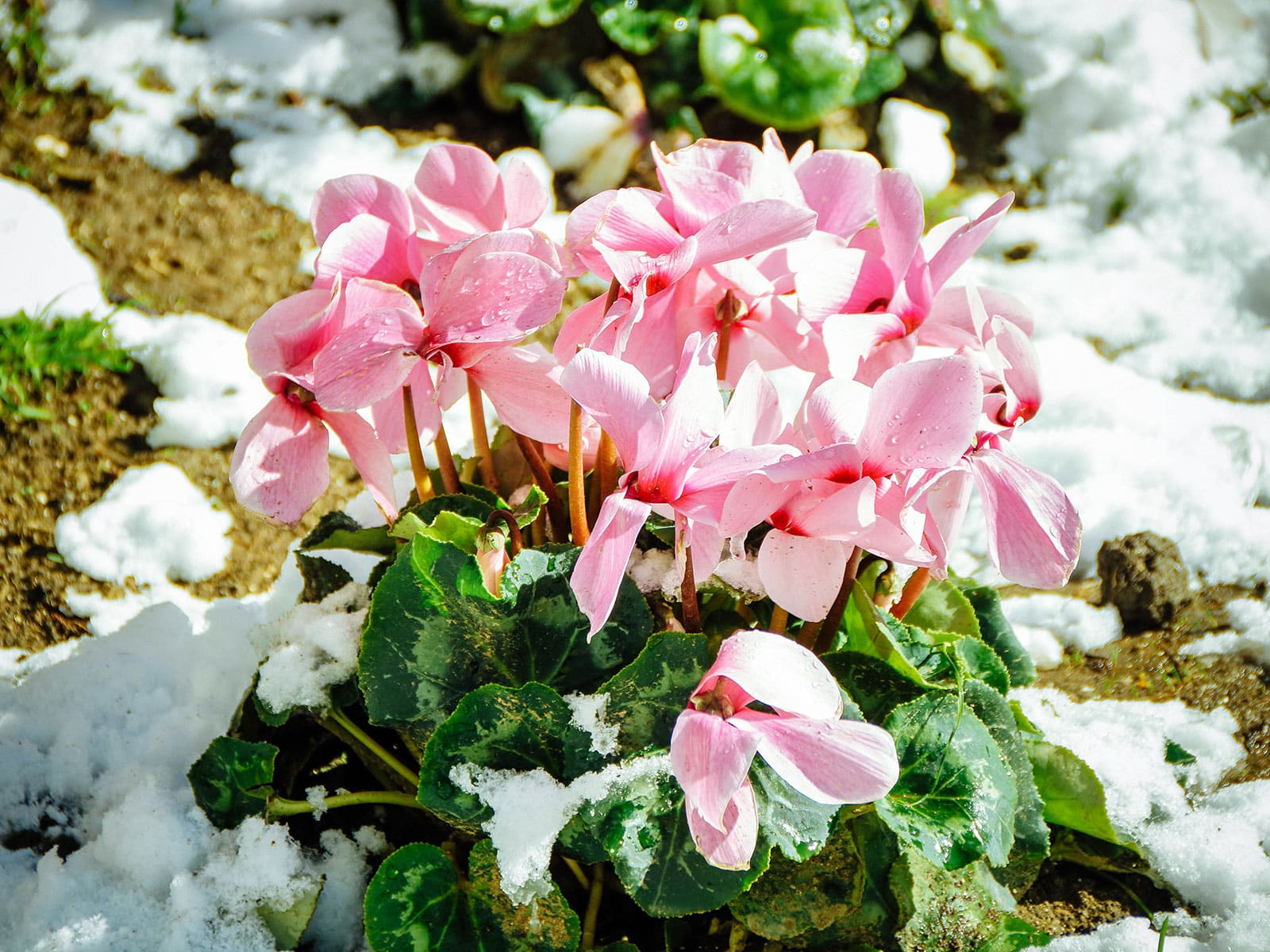
Winter Cyclamen (Cyclamen coum)
- USDA Hardiness Zone: 4–8
- Sun Exposure: Partial shade
- Bloom Time: February to April
- Height/Spread: Up to 6 inches tall and wide (will form larger clumps over time)
You may know that indoor Cyclamen varieties like C. persicum are winter-blooming favorites for houseplant lovers. But were you aware that outdoor gardeners can also enjoy their elegant rose-colored flowers and heart-shaped leaves as early as February? Perfect to plant around a nice tree or shrub!
Winter Cyclamen is a tuberous plant that spreads quickly and is surprisingly hardy. It’s unfussy and not attractive to critters due to its toxicity.
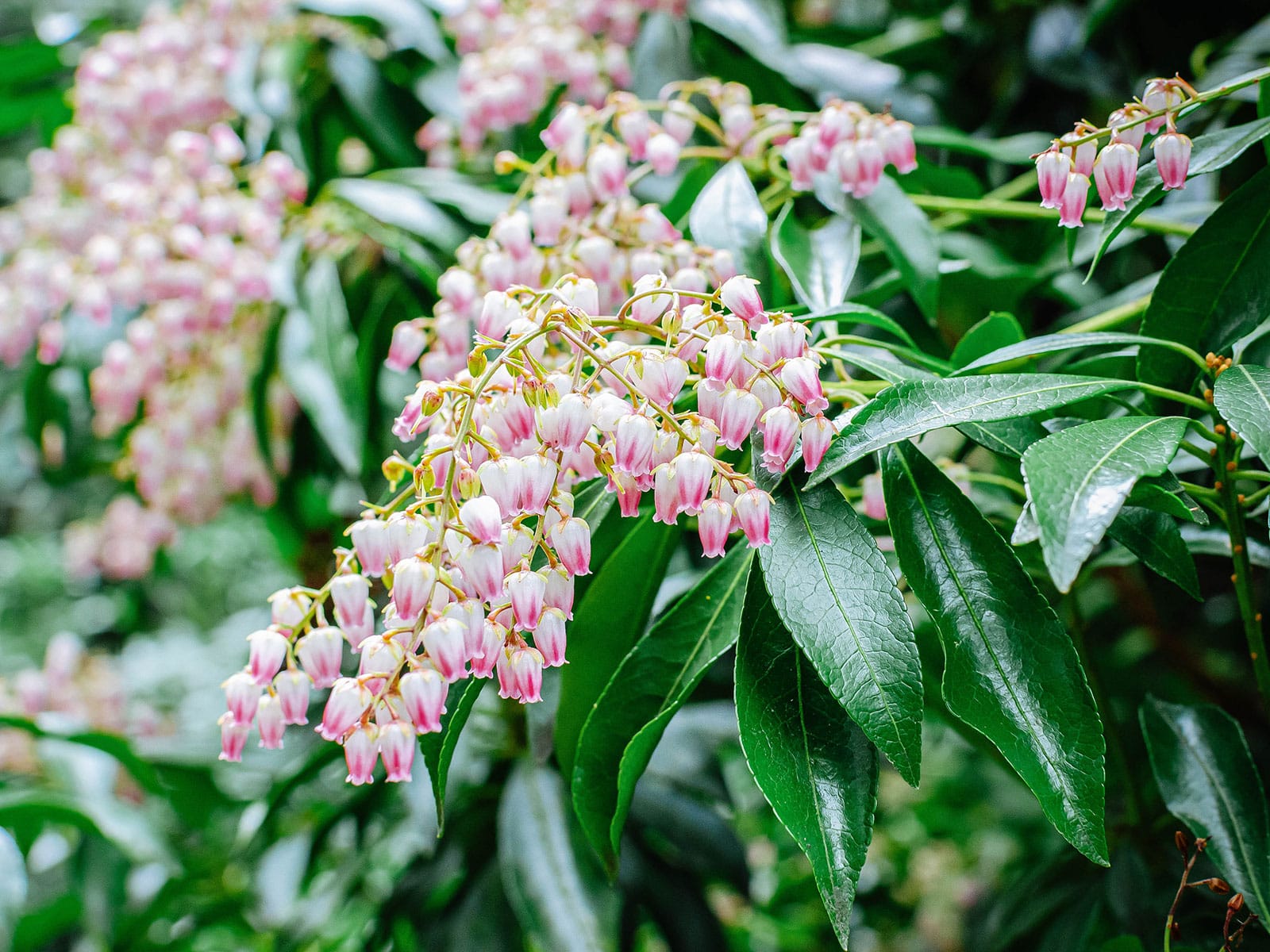
Japanese Andromeda (Pieris japonica)
- USDA Hardiness Zone: 5–8
- Sun Exposure: Partial shade
- Bloom Time: February to April
- Height/Spread: Up to 12 feet tall and 8 feet wide
The beautiful, clustering, bell-shaped flowers on Japanese Andromeda remind me of winter heath ( which is also on this list), but significantly bigger. And it doesn’t stop there: many cultivars also sport striking colors, like bright red, on their new foliage.
This medium-sized evergreen shrub is highly versatile and a breeze to grow in partial shade and somewhat acidic soil. Critters don’t like it much, but pollinators do; the flowers provide a valuable early source of food for bees and butterflies.
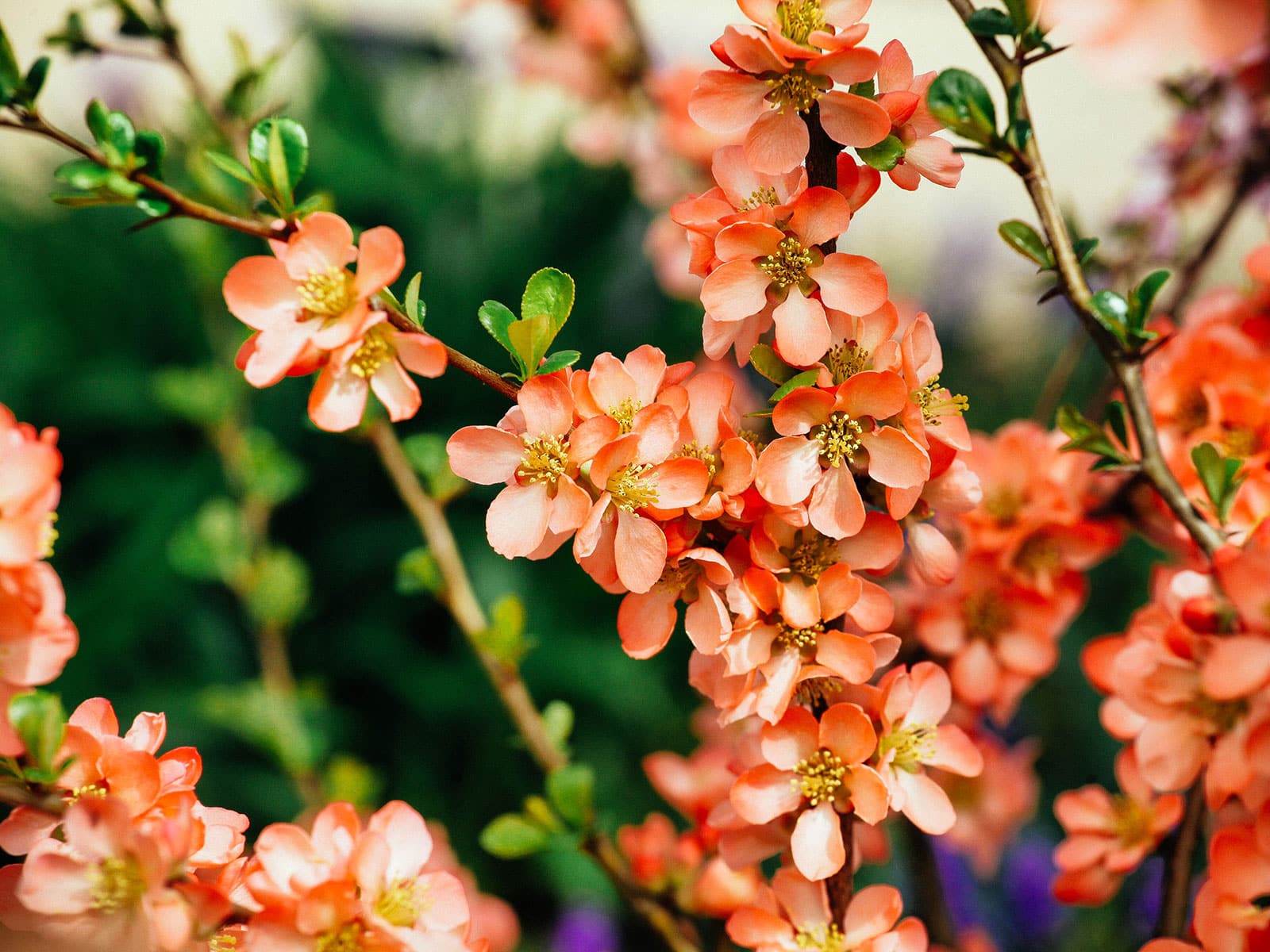
Flowering quince (Chaenomeles spp.)
- USDA Hardiness Zone: 5–9
- Sun Exposure: Full sun to light shade
- Bloom Time: February to April
- Height/Spread: Up to 10 feet tall and wide
Flowering quince of the genus Chaenomeles is not the same as true quince—a related tree in the genus Cydonia that produces tasty fruit—but it’s more than worth growing in your garden thanks to its hardy nature, unfussy attitude, resistance to critters, and loads of other positive characteristics.
The gorgeous early blooms in various shades of red, white, orange, and more can look a lot like clusters of small roses, although the single-petaled varieties also remind me distinctly of fruit tree blossoms.
Where to buy
Bulbs and live plants
March Bloomers
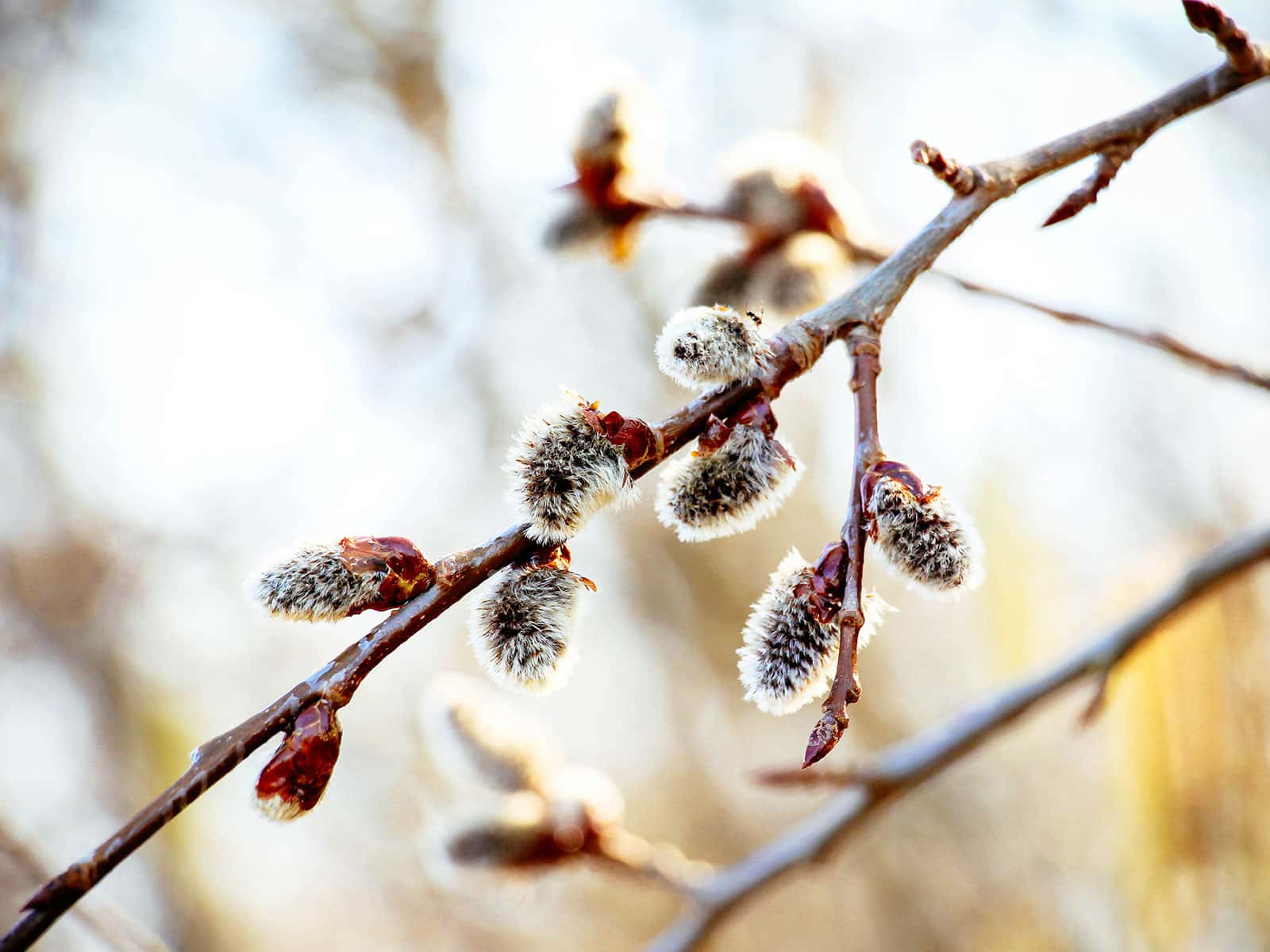
Pussy willow (Salix spp.)
- USDA Hardiness Zone: 3–9, but highly dependent on species
- Sun Exposure: Full sun
- Bloom Time: March to April
- Height/Spread: Up to 20 feet tall and 12 feet wide
Few things scream “spring is coming!” like the pussy willows bursting into bloom! I can never resist cutting a few of the branches dotted with fuzzy catkins to bring inside. And did you know these small trees are incredibly hardy, with some doing well down to Zone 2?
Pussy willow trees are extremely versatile and a great early food source for pollinators. They’re considered easy to grow as long as they get enough sun, and their highly branched growth pattern makes them real eye-catchers.


